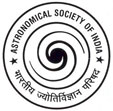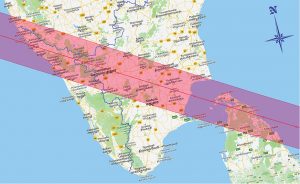Annular Solar Eclipse - 26 December 2019
A ring (or a crescent) of fire ... fusion, to be prescise!

Pic: Dhruv Paranjpye
On the morning of 26th December this year, as we look towards the eastern sky, we can see a dance of shadows unfold with the Sun and our Moon lining up to make a Solar Eclipse. For a small belt in South India, the eclipse will be an beautiful annular (ring-shaped) one, since on that day the Moon is not close enough to cover the Sun's face completely.
"The eclipse will be seen as Annular in some parts of Southern India and Partial in the rest of the country. This event unites the entire country - so let's all enjoy this natural spectacle safely!" - Aniket Sule, Chair, POEC
This spectacle, coming right in the winter holidays, will be a good reason for all to go outside and enjoy breakfast with a view over the few hours. We wish all our friends, family, and our communities to see it too. Hence all relevant information is being made available here to see the event safely and learn some facts about eclipses - which have been known to be harmless, natural phenomena right from the times of Āryabhaṭa!
If you are organising a local event where members of the public can come and watch the eclipse with you, please do register your event with us. We will then put your event on our map, so that others can join you as well. If you have a small telescope, that is great, but we can all enjoy the eclipse without one too, so do not let that stop you!
Join us to celebrate and share this wonderful event
The ASI-POEC has created a resource base on this page for anyone to see and share the eclipse. Scroll below for Maps and Tables, Event Lists, Information on observing safely, Teaching resources and a Glossary.
The timings and maximum fraction of the Sun getting covered in this eclipse will differ with your location. All places in India will see this completely and early in the morning. The shadow of the moon will be seen earlier in the West and the Moon's limb will cover the Sun later for those who reside eastwards in Longitude. For example
| City | Maxima Time | Sun coverage |
| Ahmedabad | 09:22 IST | 67% |
| Coimbatore | 09:30 IST | 93% (Annular) |
| New Delhi | 09:30 IST | 47% |
| Vizag | 09:40 IST | 66% |
| Kolkata | 09:50 IST | 45% |
| Dibrugarh | 10:12 IST | 27% |
To figure out which stages of the eclipse you can see, use this handy calculator made by Xavier M. Jubier or take a look at our resources.
Find the public events happening near you
Click icons for details. Do check back again as events are still being registered.
Live Webcasts (planned)
If you have clouds you may find these links useful.
Regional Science Centre Calicut Live
Live Webcasts (additional on eclipse day)
If you have clouds you may find these links useful.
https://www.youtube.com/watch?v=LrQswMdbrVY
https://youtu.be/ABAim_BpYoc
Suryotsav (2019-2020)

Initiated by the Navnirmiti Learning Foundation, the Suryotsav celebration seeks to unite the educators' and science popularisers' community to make best use of the two consecutive annular solar eclipses to be seen from India in Dec 2019 and June, 2020. Please join. The collection of activities is mentioned has been released through this Suryotsav Handbook. The celebrations with these and other daytime astronomy activities should be held anytime before the solar eclipses. The schools, students and teachers who participate in the Suryotsav should organisse eclipse viewing sessions on 26th December.
Eclipse specific resource material
Information and Activity Handbooks
- Detailed maps & times for Annularity (by Bipash Das Gupta, M.P. Birla Planetarium, Kolkata) (22 MB)
- Concise B&W booklet for Annularity (by Bipash Das Gupta, M.P. Birla Planetarium, Kolkata) (10 MB)
- Suryotsav Handbook (by Navnirmiti group) (1 MB)
- SkyNews Eclipse Special (by Arvind Paranjpye, Nehru Planetarium, Mumbai) (500 KB)
- Eclipse Activity Handbook (by Shivom Gupta, IUCAA, Pune) (1.9 MB)
Relevant and useful teaching material
Solar Eclipse App (by Alok Mandavgane)
Resource material for Teachers' workshop (ASI-2016)
- Universal Astronomy (English) (14 MB)
- Universal Astronomy (Urdu) (3 MB)
- Astro Roleplay Activities (English) (5 MB)
- Astro Roleplay Activities (Urdu) (7 MB)
Using Telescope or Binoculars:

A simple projection setup made from a cardboard shield and a piece of white paper as a projection surface. Image © Sky & Telescope
Warning: It is very dangerous to observe the Sun through any unfiltered optical system (lenses, binoculars, telescopes & even your bare eye). This may cause serious eye damage and even blindness. The Eclipse observation also involves looking at the Sun. Although it will be partially covered, all the precautions that apply to the observations of the Sun apply here too and are essential.
* Projections with small telescopes, would be ideal. We recommend this method as it can give you larger images and they can also be shown to many people. Please see this link for various methods of Projecting the Sun.
* Good quality "Eclipse goggles" (without any tiny holes in them!) may be used.
* Another arrangement will be to put Mylar sheets or commercially available Solar filters in front of the objectives of the binoculars / telescopes that you are using. The magnification provided by a binocular should suffice to show the event. Warning: These filter need to be put so that they cut out light BEFORE it enters the telescope. Make sure of that before you put your eye to the eyepiece.
What will I see … & is it ok to see it?
Yes! It is absolutely okay to see the eclipse, and share the joy of the event with people you know.
We need to take precautions while seeing a solar eclipse. Any accidental viewing of the uneclipsed part of the Sun, especially through a telescope, can permanently damage the eyes. Even so, hundreds of millions of people regularly see solar eclipses safely using solar filters and other devices. If this kept in mind, there is no other danger.
You may hear that one should stay indoors and not eat during an eclipse, etc. These kinds of beliefs are common around the world have no basis in science. They come from an age when humans did not understand the sky and were easily frightened by eclipses. We would do well to follow the great astronomer Aryabhata (476-550 C.E.) who gave the correct explanation of eclipses as well as a method to calculate them, and did not believe in any of the myths surrounding these events. For further reading on Aryabhata, eclipses, and myths versus science, read this article
So, you can see the eclipse with some precautions and you can even eat during the eclipse. In short, there are no harmful effects from seeing the eclipse on 26 Dec.
An eclipse is one of the most grand and awe-inspiring spectacles that nature has to offer us. Why would we not want to see it?
MORE USEFUL RESOURCES
Countering Pseudoscience and Misconceptions
- Who is afraid of Eclipses (by Aniket Sule, ASI-POEC) (500 KB)
What do these terms mean?
An annular solar eclipse : This kind of eclipse occurs when the moon covers the sun, but leaves out the latter’s outer edges that resemble a ring (latin:annulus) of sunlight.


Nice meeting
I like this website
I’m very happy to conduct this festival of solar eclipse
Please inform any other even if you conduct
thank you
Student see the solar eclipse
Solar eclipse see the students and develop our knowledge and improve the science subject.
Anullar solar eclipse good chance to understood about sun moon and earth for students and the public